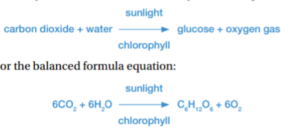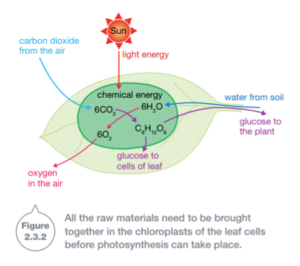- Almost all life on Earth depends on two processes; Photosynthesis and respiration.
- Plants use photosynthesis to make glucose, which stores energy for later use.
- Respiration is also used by animals (including humans) to release energy from the glucose they have absorbed from their food.
Photosynthesis
Photosynthesis is a series of chemical reactions that green plants use to produce sugar glucose.

Obtaining the raw materials for photosynthesis
Photosynthesis needs carbon dioxide and water as reactants.

sunlight
Sunlight passes into the cells containing chloroplasts. Within the chloroplasts is a green-colored chemical called chlorophyll, which helps convert light energy from sunlight into chemical energy that the plant can use. The chloroplasts also contain enzymes. These are helper chemicals that speed up the reactions of photosynthesis happening there.
Water
Water is carried from the roots up the plant’s transport system and into the leaf. It moves from the transport system into the cells and then into the chloroplasts
Carbon dioxide
Carbon dioxide moves by a process called diffusion from the air through tiny openings in the leaf called stomata. The concentration of carbon dioxide in the air is higher than in the leaf because photosynthesis has used it up in the leaf. Carbon dioxide continues to move diffusion through air spaces in the lower part of the leaf to the chloroplasts in the cells of the upper layers.

Respiration
Plant and animal cells need a constant supply of energy in order to function. They get this from a process called respiration, which releases energy from glucose. Plants get their glucose from photosynthesis. Animals get glucose through the digestion of the food they eat.
Glucose molecules are made up of carbon, hydrogen and oxygen atoms. Energy is released when these molecules are broken into smaller ones. this energy is then available to the organisms for tasks such as growth, repair, movement, and reproduction.
Plants use a form of respiration called aerobic respiration to release this energy. Animals also use aerobic respiration most of the time. Aerobic respiration needs a supply of oxygen as well as glucose. This is why you breathe. When exercising, the increased rate and depth of breathing remove carbon dioxide waste while supplying more oxygen to the bloodstream.
The reaction can be represented by the following chemical equations:
![]()


